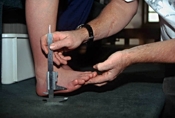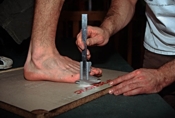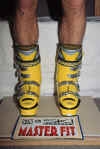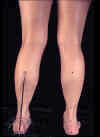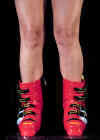Every boot sale, foot-bed sale, or boot fitting begins with a bio mechanical evaluation. The ankle joint is the most vital joint to understand when doing this. What we examine is ankle joint dorsiflexion. Too much dorsiflexion and you will be over flexed, which means you do not have room to flex forward while you are skiing. Too little and you are skiing in the back seat. With proper heel or toe lifts and forward lean angles set, then your stance will be balanced. |
|
| Let's take a look at what's going on inside these boots! The image on the right is an example of too much dorsiflexion (note the gap between the toes and the platform). When this foot is placed flat in the boot, the natural angle of the ankle joint will bring the leg (specifically the tibia) forward and then the skier will be always at the maximum flex the boot allows and there will not any room to actually flex the ankle! To allow room to flex the ankle in the boot, the heel needs to be positioned lower than the toes. |
|
|
| The image on the right demonstrates no dorsiflexion. Positioned flat in the boot this skier is going to be chronically in the back seat. The ankle cannot flex forward enough in the boot to achieve a balanced stance. This skier needs to have the heel lifted in the boot so the ankle can flex forwards properly. We establish the correct alignment through custom footbeds and other interior boot work. |
|
|
|
A minority of skiers have perfectly aligned legs, the rest of us are bowlegged or knock-kneed. On many boots the adjustment for this is inappropriately labeled as a cant adjustment, but the goal is to align the boot cuff to the shaft of the leg. |
|
In the pictures to the left, the skier is clearly slightly knock-kneed, and the boot cuff needs to be adjusted inwards to conform to the leg. If this isn't adjusted correctly, then the boot will rotate to follow the leg, and the sole of the boot will never be flat (which means the skier will be not be on a flat ski). |
| Once the boot cuffs are adjusted properly, then a cant evaluation is performed. For the most efficient alignment for skiing, the knees should be slightly in (never bowed). To achieve this, the boot soles can be ground to the correct angle or cant shims can be installed under the binding on the ski. However, we have found that certain models of boots work better for certain body types, and if you are willing to go the distance and get the correct boot/ski setup, then a cant adjustment is not necessary nine times out of ten! |



